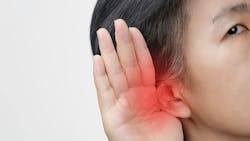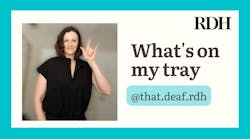Enhancing health care: Effective communication with deaf and hard-of-hearing patients
In the realm of health care, effective communication is paramount. It ensures that patients receive the best dental care possible, understand their diagnoses and treatment options, and feel valued and respected. When it comes to communicating with deaf or hearing-impaired patients, dental professionals must be well equipped with knowledge and strategies to bridge any communication gaps.
Research shows that only 59% of deaf patients fully understand their clinicians.1,2 Hearing loss impacts 1.5 billion people globally, and about 15% of Americans (37.5 million) report some problems with hearing.3
In this article, we’ll explore the principles of effective communication with deaf patients and how dental care providers can implement them to deliver patient-centered care.
Get the deaf person’s attention before speaking
One of the best ways to gain a deaf person’s attention is by giving them a light tap on their shoulder or a wave in their line of vision. Instruct the front desk personnel to ask about the best way of gaining the deaf patient’s attention. Some of them prefer flickering light.
Book an interpreter
We need to keep the patient’s health information private. This is why patients should not use a friend or family member to interpret for them. Relatives might not know medical terminology or be trained to interpret health information. In the presence of a friend or family member, a patient might not disclose full information. Some nonprofessional interpreters, such as family members or friends, may not always follow ethical rules or keep patients’ health information confidential.
Learn sign language
Ideally, one of the most effective ways to communicate with deaf patients is by learning sign language. However, becoming fluent in American Sign Language (ASL) or other local sign languages may not be feasible for every dental provider. Basic medical sign language can go a long way to bridge the gap.
Train your coworkers
Effective communication extends beyond the doctor-patient interaction. Ensure that the entire dental team (including hygienists, assistants, and receptionists) are trained in communication techniques for deaf patients. This can involve basic sign language skills, familiarity with communication devices, and understanding the importance of clear communication. When you schedule a new-patient exam, establish a protocol in which the receptionist asks the patient if they need any extra assistance.
Assess communication preferences
Recognize that each deaf patient may have their preferred method of communication. Some may prefer ASL, while others may opt for written communication, lip-reading, or technology-assisted solutions. Begin each interaction by asking the patient about their preferred mode of communication.
Maintain eye contact and clear speech
When speaking with deaf patients, ensure that you face them directly, maintain eye contact, and speak clearly at a moderate pace. Visibility of your lips can assist those who rely on lip-reading to understand your words. Talk directly to your patient; don’t talk solely to the interpreter. Repeat and rephrase if necessary. Trying to say the same thing in a different way might help. Always make sure your face is out of any shadows and there are no strong lights in the patient’s eyes. Avoid standing in front of a light source such as a window, bright sunshine, or strong lights because it creates a dark shadow on your face.
Be expressive with your body gestures and facial expression
Body language can be very helpful in ordinary life communication too. Improve the quality of your communication by bringing more life and interaction into it. Make sure your facial expression follows your explanations. Remember, not all hard-of-hearing or deaf persons can read lips. You can use the thumbs-up sign to show that there is nothing to worry about. Use mimicking if something is painful. Point to the area of the face or neck where the problem is located. If you are going to take an x-ray, point there.
Use visual aids
Medical information can be complex, but visual aids can simplify the explanation of medical conditions, treatments, and procedures. Employ the use of diagrams, anatomical models, and medical illustrations to help convey essential information.
Provide written information when possible
Offer written instructions, medication details, and appointment reminders to ensure that the patient has access to crucial health-care information. This empowers patients to reference this information as needed. Dental hygienists can make sure pamphlets or handout materials about caries, gum disease, and oral cancer are ready for distribution. Some of these materials are available on the ADA website. If you choose to write down the information, make sure that you explain it in detail. Some patients say doctors don’t want to or cannot write a full explanation.
Use technology
Explore the use of communication technology to facilitate real-time conversations. Video relay services (VRS) and communication apps can bridge communication gaps effectively, especially in emergencies or during remote consultations. Even simple texts in a notepad app can help. There are special systems with teletext that can be implemented in dental offices. Doctors’ recommendations can be written on the screen. Some computer programs can provide visual and auditory feedback in response to sound, such as SpeechViewer III.
Be patient and allow extra time
Recognize that communication with deaf patients may require more time. Allocate additional time for appointments to ensure thorough understanding and discussion. This will foster a sense of patient-centered care.
Encourage trust and openness; respect confidentiality
Create a welcoming and supportive dental care environment where deaf patients feel comfortable in expressing their concerns and asking questions. This builds trust and encourages open communication. Ensure that all staff members, including interpreters, are trained in maintaining patient confidentiality and privacy during dental interactions. Trust and privacy are paramount in health care.
Be mindful of the deaf person during consultation or treatment
If someone knocks on the door or asks you something, the first thing to do is to let the deaf person know that you need to answer someone’s question. Remember, they cannot hear what is happening. If you have to leave the room, explain the situation to the deaf person so it won’t look as if you are disappearing in the middle of the conversation. It would be as disrespectful for your deaf patients as it is for anyone else.
Ask for feedback
Encourage patients to provide feedback on their communication experiences. Inquire about specific communication preferences or needs they may have. Show your commitment to tailoring care to their requirements. Some dental offices use paper or online surveys after dental visits.
Offer emotional support
Deaf patients may face unique challenges related to their dental needs. Be empathetic, offer emotional support, and consider any emotional or psychological factors that may impact their health.
Cultural sensitivity
Familiarize yourself with Deaf culture and its values to ensure culturally sensitive care. This includes understanding the importance of identity, community, and the deaf community’s shared experiences.
Continuing education
Stay updated on advancements in technology and communication methods that can benefit your deaf patients. Being well-informed enables you to provide inclusive and patient-centered dental care.
My personal experience
I am a foreigner, and there are many foreigners in our profession. For us, English is a second language, and we might wonder if a deaf patient will be comfortable with us. I have had this experience in my life. During the pandemic, we had to wear masks at all times. Luckily, I had a clear one. I used this mask to meet and greet my patients. My first deaf patient was happy to see my face since she was able to read lips. Using my normal voice tone, speed, and articulation, I asked standard medical history questions, and I explained the treatment we were supposed to do that day. We also had a chance to talk a little about random topics. Later, I realized that my patient was comfortable talking and understanding me. If you adopt some of the rules in this article, you might achieve more effective communication with your deaf or hearing-impaired patients, especially when English is your first language.
Effective communication with deaf patients is essential for accurate diagnosis, treatment, and the establishment of a positive provider-patient relationship. By adhering to these principles and strategies, dental care professionals can ensure their deaf patients receive the highest standard of care and promote equitable dental care access for all.
Editor's note: This article appeared in the June 2024 print edition of RDH magazine. Dental hygienists in North America are eligible for a complimentary print subscription. Sign up here.
References
- Zazove P, Niemann LC, Gorenflo DW, et al. The health status and health care utilization of deaf and hard-of-hearing persons. Arch Fam Med. 1993;2(7):745-752. doi:10.1001/archfami.2.7.745
- Public law 101-336, 42 U.S.C. 12101, et seq. US Department of Justice. Civil Rights Division. Disability Rights Section. Communicating with people who are deaf and hard-of-hearing in hospital settings – 2011. https://www.govinfo.gov/content/pkg/STATUTE-104/pdf/STATUTE-104-Pg327.pdf
- World Report on Hearing. World Health Organization. 2021. https://www.who.int/publications/i/item/9789240020481
About the Author

Ella Peshkova, PhD, CRDH
Ella Peshkova, PhD, CRDH, is a dentist from Russia. She earned a PhD in medicine and is a practicing dental hygienist in Florida, industry educator, and college professor. She is an international speaker and the author of two monographs and more than 26 articles. Dr. Peshkova has been in the dental field for more than 15 years.


